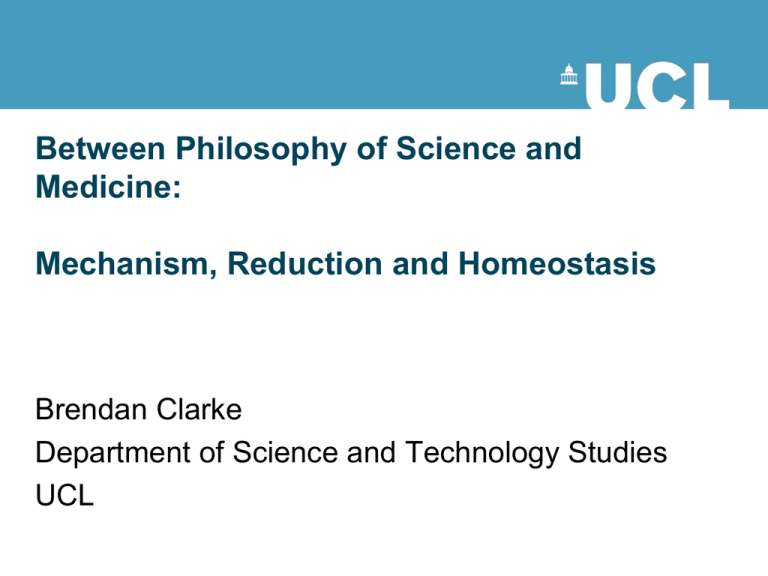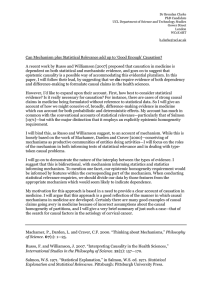Between Philosophy of Science and Medicine: Mechanism, Reduction and Homeostasis Brendan Clarke
advertisement

Between Philosophy of Science and
Medicine:
Mechanism, Reduction and Homeostasis
Brendan Clarke
Department of Science and Technology Studies
UCL
How can we talk about causation in
an homeostatic mechanism?
•
•
•
•
Reductive causal explanations
Mechanistic causal explanations
Statistical causal explanations
Russo-Williamson thesis
– Possible improvements?
How can we talk about causation in
an homeostatic mechanism?
•
•
•
•
Reductive causal explanations
Mechanistic causal explanations
Statistical causal explanations
Russo-Williamson thesis
– Possible improvements?
How can we talk about causation in
an homeostatic mechanism?
•
•
•
•
Reductive causal explanations
Mechanistic causal explanations
Statistical causal explanations
Russo-Williamson thesis
– Possible improvements?
Russo-Williamson thesis
Russo and Williamson, 2007.
• Epistemic causality supported by both mechanistic
and statistical evidence
• But how do these two types of evidence interact to
provide evidence for causation?
• Might we be able to strengthen this account by
showing how this interaction happens?
―What maintains the level
of thyroid hormone?‖
Hypothalamus
TRH
+
Pituitary
TSH
-
-
T3
+
Thyroid
T4
What is the cause of X’s x-ing?
Machamer, Darden and Craver. 2000.
Craver, 2007.
Uppercase – entity
Lowercase – activity
B – pituitary gland
C – TSH level
D – thyroid gland
E – T3 level
Each entity (B—E) has an associated set of
potential activities {b1..n},{c1...n}...{e1...n}.
So we have a range of potential activities within
our mechanism.
But which activities actually happen?
Statistical causal explanations
Salmon, Jeffrey and Greeno. 1971 ; Salmon, 1984; Salmon, 1989
• An [SR] explanation is an assembly of facts
statistically relevant to the explanandum...
[Salmon, 1984: 45]
• We give conditional probability distributions for the
chance of each activity occuring based upon its
antecedants...
• p (b1 | e1) > p (b1 | ¬e1) means that e1 is SR to b1,
hence b1 occurs because of e1
Advantages of this approach
• Reflects interdependant nature of mechanistic and
statistical evidence in making causal claims or
supporting causal explanations
• SR already takes account of some difficult causal
situations (screening off relations, partition inhomogeneity, confounding factors...)
• Hopefully tie to mechanism may ameliorate the
need for a priori judgements of causal relevance
Suggested methodology
• Formulate mechanism
• Epistemically partition data using entity/activity
pairs derived from the mechanism for both
explanandum and explanans
• Determine associated probability relations
• (Potentially) reformulate mechanism
• Repeat
References
•
•
•
•
•
•
Craver, 2007. Explaining the Brain: Mechanisms and the Mosaic Unity of
Neuroscience. Oxford: Clarendon Press.
Machamer, Darden and Craver. 2000. ―Thinking about Mechanisms,‖
Philosophy of Science. 67(1): 1—25.
Russo and Williamson. 2007. ―Interpreting Causality in the Health Sciences,‖
International Studies in the Philosophy of Science. 21(2): 157—170.
Salmon, 1984. Scientific Explanation and the Causal Structure of the World.
Princeton: Princeton University Press.
Salmon, 1989. Four Decades of Scientific Explanation. Minneapolis: University
of Minnesota Press.
Salmon, Jeffrey and Greeno. 1971. Statistical Explanation and Statistical
Relevance. Pittsburgh: University of Pittsburgh Press.




